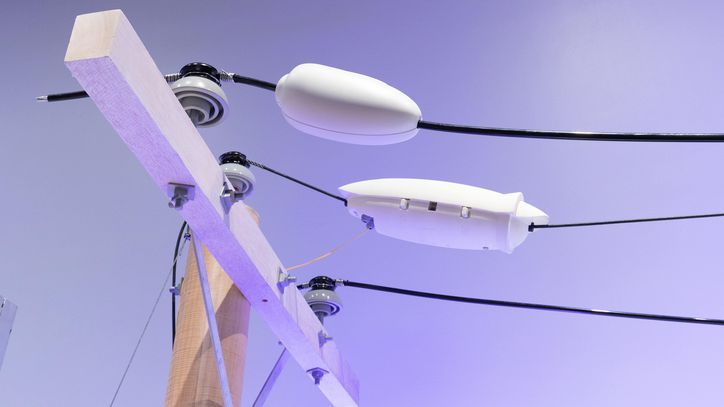Expect hundreds of megabits per second, maybe even a gigabit, even in sparsely populated areas — as long as homes are near power lines.
- by
-
Stephen Shankland

The world’s largest offshore windfarm has officially opened. The project commanding the Numero Uno status is the Walney Extension. An official inauguration was marked as September 6, and it now means that the Walney Extension overtakes the London Array as the world’s largest offshore wind farm.
How large? Stats say the farm, located in the Irish Sea off the Walney Island coast in Cumbria, covers an area of around 145 sq km (55 square miles). Project watchers are talking electricity for nearly 600,000 UK homes. It’s especially being touted as having been built on time and on budget.
It’s also being described as a “659-megawatt project.” The Danish company Orsted, PKA and PFA are the names behind this project.
4K — This is stunning! 🤪🤩💫 Goodnight, Earthlings! Credit video: Adrien Mauduit Films.
There’s something fascinating about our own home galaxy. Even if we still cannot look at it from above and gaze at the full span of its arms, the sideway view offers a quite a showdown. To me the central part of the milky way is the most spectacular sight of the night sky. It’s something you can clearly see with the naked eye when you are away from city lights. It’s a sight that really brings your down to Earth and lets you wonder at how small we are, while comforting you in the thought that you are part of this Earth and the Universe. I could gaze for hours at the central bulge and just contemplate its compelling beauty from where it rises till where it sets. From a photographic and scientific point of view, this part of the milky way is so interesting to capture and study because if our solar system is located in its suburbs, the downtown district of our home galaxy harbors billions upon billions of stars. They are so concentrated that the total light coming from them can be seen millions of light years away and really creates this halo of light visible when you take a picture of it, much like a fire blazing. However a thick blanket of dark hydrogen clouds shroud and block the complete view. You can even see these fine dark lanes with the naked eye and they really participate in making the whole picture something from another world. Of all of them the Pipe and Dark Horse nebulae are descending down the core obscuring the upper part of the central bulge. In addition to this celestial show many emission nebulae- reliques of previously exploded stars, pepper the disc. Among them the bright and colorful Lagoon nebula, the pink and blue Trifid nebula, the red Cat Paw, War and Peace and Prawn nebulae around Scorpius. Moreover many star clouds (like the Sagittarius star cloud) and other remarquable star clusters also participate in strewing this already full frame. Finally the closest stars (like Antares) and near planets visible during the time of shoot (Mars, Saturn, Jupiter) also give a sense of just how ridiculously big the distance between Earth the core is.
Being fascinated by the core since I started astrophotography where it was barely visible (Denmark), I started looking for the best places in the northern hemisphere where I could get a clear view. The first time I really saw it was on the beautiful island of Tenerife 4 years ago and I sincerely will remember that experience for the rest of my life. Gazing upon the center of our galaxy in its full glory is something everyone ought to try. That’s why I decided to dedicate the third opus of my astrolapse series ‘Galaxies’ exclusively to the core, assembling my best clips to date and bringing them to the public, mainly to raise awareness and to get our night sky a bit more attention. I was appalled by just how many people have never seen the milky way so maybe by showing the true beauty of the universe I could contribute in my own limited way to bringing the real dark skies to the hectic and light polluted urban jungle.
The goal once again was to use the best techniques in astrophotography and time-lapse to exploit each frame to its maximum without compromising the quality. From planning, to traveling to remote locations, to shooting with some of the best astro-gear, and eventually finding a novel post-processing workflow, I was able to get some astounding and never-seen-before sequences of the core. Traveling to very elevated and dark places allowed me to get the best signal to noise ratio as well as the best ‘contrast effect’ in the halo created by the stars in the bulge. The array of extremely sharp and bright lenses I utilized permitted to decrease shutter speed and get less motion blur while getting extremely clean shots with little aberration.
We are not alone in our concerns related to the current paywalling of science. Earlier this year, researchers at Clarkson University in Potsdam, New York decided that this problem deserves the attention of decision makers and the general public, and they started producing a documentary in order to reveal the flaws of the existing system of scientific publications and to propose solutions. This documentary is Paywall: The Business of Scholarship.
The producer of the documentary, journalist and filmmaker Jason Schmitt, contacted university representatives, university and public libraries, open access publishing houses, and researchers around the globe to ask them if they have ever hit paywalls and how paywalls affected their professional activities.
Sections of cities all over the world are being demolished to meet increasing demand for transport infrastructure. The process of building new roads, harbour crossings, metro systems and light rail lines seems unending. Large-scale construction includes loss of public space, housing and backyards.
Historic suburbs, such as Sydney’s Haberfield, have suffered. And then there’s the issue of cost blow-outs and traffic gridlock. There are rumblings, too, about environmental impacts and equity of access. But there is actually one public transport option that can mitigate many of these concerns: cable cars.
Cable cars now grace many urban skylines, including some of the world’s most populous, congested and poorest cities, such as Colombia’s city of Medellin, but also the US city of Portland. These cities have integrated cable cars with existing transport networks. The newer versions are cheap, quick to build and solar generating. Perhaps it’s time for Australia to start looking skyward for solutions.

Germany helped make solar power cheap. As of June this year, it boasts 1 million homes that have installed rooftop solar panels. That means the country produces a lot of renewable energy—sometimes more than it can use.
At such times, German grid operators have had to pay neighboring countries or grids to use the excess electricity. Since the beginning of this year, German grids have accumulated 194 hours (paywall) with negative power prices.
Now Germany is turning to energy storage as a solution to the problem of excess electricity. On Aug. 28, an energy ministry official attended the commissioning (link in German) of the 100,000th home to install a battery-storage system that’s connected to the grid.

With threats of sea level rise, storm surge and other natural disasters, researchers from Florida Atlantic University’s College of Engineering and Computer Science are turning to nature to protect humans from nature. They are developing innovative ways to guard coastlines and prevent scouring and erosion from waves and storms using bioinspired materials that mimic mangrove trees found along shores, rivers and estuaries in the tropics and subtropics. Growing from a tangle of roots that twist their way out of the mud, mangrove trees naturally protect shorelines, shelter coastal ecosystem habitats and provide important water filtration. In many cases, these roots trap sediments flowing down rivers and off the land, helping to stabilize the coastline.
Certain mangrove root systems even have the ability to dissipate tidal energy through unique hydrological flows and divert the energy of water in different directions reducing risk of coastal damage. Yet, to date, few studies have examined the fluid dynamics such as flow structure and drag force on mangrove roots.
For a study, published in the American Physical Society’s journal, Physical Review Fluids, researchers singled out the red mangrove tree (Rhizophora mangle) from more than 80 different species of mangroves, because of its robust network of roots that can withstand extreme environmental conditions. The red mangrove provided the researchers with an ideal model for bioinspired shoreline applications.
A sapphire-colored dye called methylene blue is a common ingredient in wastewater from textile mills.
But University at Buffalo scientists think it may be possible to give this industrial pollutant a second life. In a new study, they show that the dye, when dissolved in water, is good at storing and releasing energy on cue.
This makes the compound a promising candidate material for redox flow batteries—large, rechargeable liquid-based batteries that could enable future wind farms and solar homes to stockpile electricity for calm or rainy days.

The algorithm is saving about $10 million as part of an effort to replace the city’s water infrastructure.
To catch you up: In 2014, Flint began getting water from Flint River rather than the Detroit water system. Mistreatment of the new water supply, combined with old lead pipes, created contaminated water for residents.
Solving the problem: Records that could be used to figure out which houses might be affected by corroded old pipes were missing or incomplete. So the city turned to AI. Using 71 different pieces of information—like the age or value of the home—Georgia Tech researchers developed an algorithm that predicted whether or not a home was connected to lead pipes.
The habitat is designed to form one module of NASA’s proposed Deep Space Gateway, a miniature space station that would orbit the moon and serve as a way station for lunar missions or journeys deeper into the cosmos.
Lockheed’s prototype is the refurbished Donatello cargo container that was originally designed to fit inside the space shuttle’s cargo bay and ferry supplies to and from the ISS. Donatello never flew in space, but its two sister modules made several trips aboard the shuttle. One, dubbed Leonardo, is now a permanent “space closet” attached to the space station.
Lockheed is one of six companies awarded a combined $65-million contract from NASA to design a deep-space habitat as part of the agency’s Next Space Technologies for Exploration Partnerships (NextSTEP) program, which aims to foster commercial developments for space exploration.